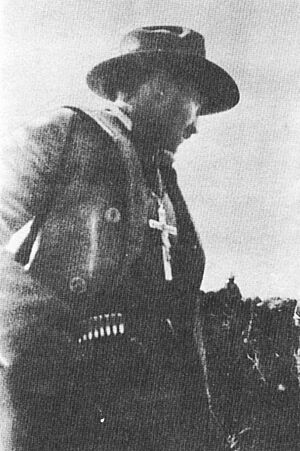Enrique Gorostieta facts for kids
Quick facts for kids
Enrique Gorostieta
|
|
|---|---|
 |
|
| Born | 1889 Monterrey, Nuevo León, Mexico |
| Died | June 2, 1929 (aged 39–40) Atotonilco el Alto, Jalisco, Mexico |
| Allegiance | |
| Rank | General |
| Battles/wars | Mexican Revolution Cristero War |
| Other work | Soap manufacturer |
Enrique Gorostieta Velarde (born in Monterrey in 1889, died in Atotonilco el Alto on June 2, 1929) was a Mexican soldier. He is most famous for leading the Cristero War as a general.
Contents
Life of Enrique Gorostieta
Early Years and Military Training
Enrique Gorostieta was born in Monterrey. He came from an important family with Basque roots. He had a regular education, not focused on religion. His father was a lawyer and businessman. Enrique's mother encouraged him to join the military. He enrolled at the Heroic Military College of Chapultepec in 1906.
After graduating in May 1911, he joined the army. He served under Victoriano Huerta. He fought against leaders like Emiliano Zapata and Pascual Orozco. During Huerta's time as a dictator (1913-1914), Gorostieta's father was the Secretary of the Treasury.
Role in the Mexican Revolution
During the Mexican Revolution, Gorostieta served in the Federal Army. This army supported the dictator Victoriano Huerta. Gorostieta was the youngest general under Huerta. After Huerta's government fell, Gorostieta fought with Juan Andreu Almazán. Soon after, he left Mexico. He lived in Cuba and then the United States.
When he returned to Mexico, he worked making soap. But he found this work boring. He wanted to return to military life.
Leading the Cristero War
In 1927, a group called the National League for the Defense of Religious Liberty asked him for help. They offered him command of the Cristeros. The Cristeros were Catholic rebels. They were fighting against the Mexican government. The government, led by President Plutarco Elías Calles, was restricting religious freedom.
Some people thought Gorostieta was against the church. But his letters show this was not true. He took command for several reasons. He was offered a good salary. He also had political goals. Most importantly, he strongly believed in defending religious freedom.
Gorostieta created a plan in 1928. It called for changes to the 1917 Mexican Constitution. The Cristeros felt this constitution limited the rights of Catholics. Gorostieta wanted a government based on Classical Liberalism. This meant the government should not interfere with religion. He respected the fighting skills of the farmers under his command. He believed he could train them into a strong army.
Impact as a Cristero Leader
Gorostieta was very important as a Cristero leader. He brought military order to the rebels. Before him, they were not well organized. He helped turn their small groups into a real army. For a while, this army won battles. They fought in rural areas like Jalisco, Michoacan, Colima, and Zacatecas.
However, the Cristeros did not have support from the Mexican church leaders. They also lacked support from the Vatican. The movement also had internal problems. Eventually, a peaceful agreement was reached. This agreement was between the Vatican and the Mexican government. It clarified the Church's rights under the Constitution.
Death of General Gorostieta
Final Days and Betrayal
Gorostieta was killed on June 2, 1929. This was 19 days before a ceasefire was to begin. The ceasefire was part of an agreement. It was worked out by U.S. Ambassador Dwight Morrow. The agreement was between Pope Pius XI and Mexican bishop Pascual Díaz y Barreto.
Gorostieta was trying to retreat into Michoacán. He hoped to find more followers there. He wanted to continue the rebellion. However, a Mexican government spy had joined Gorostieta's group. This spy was a mole. The mole told the Mexican cavalry where Gorostieta was.
Killed in Action
The cavalry found Gorostieta in Atotonilco, Jalisco. He was killed in a short gunfight. His death marked a significant moment. It happened as the Cristero movement was quickly ending.
See also
 In Spanish: Enrique Gorostieta Velarde para niños
In Spanish: Enrique Gorostieta Velarde para niños

